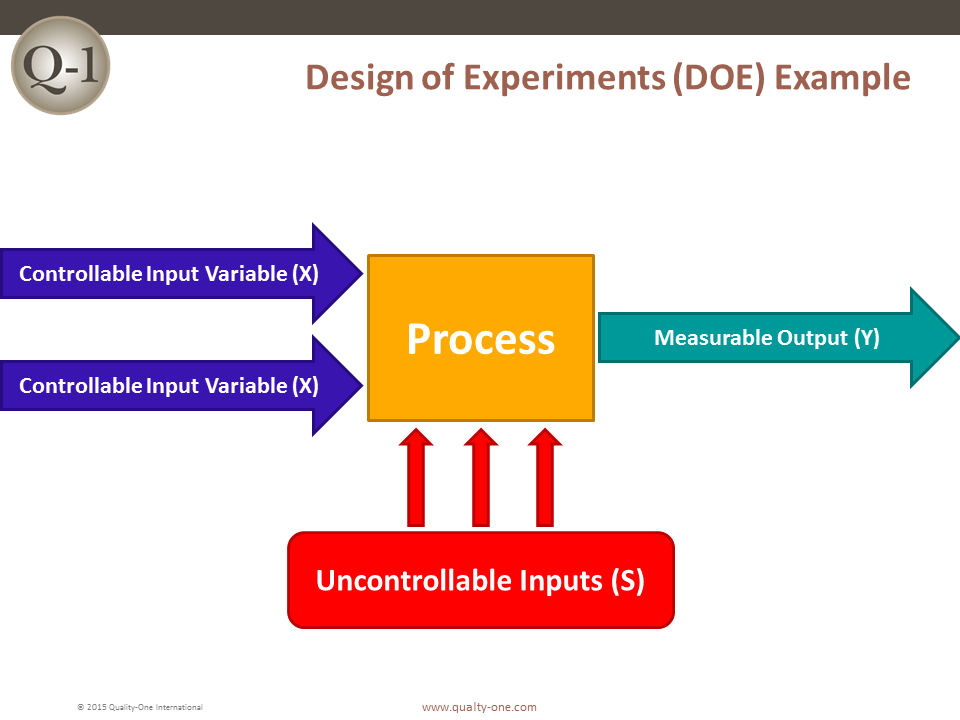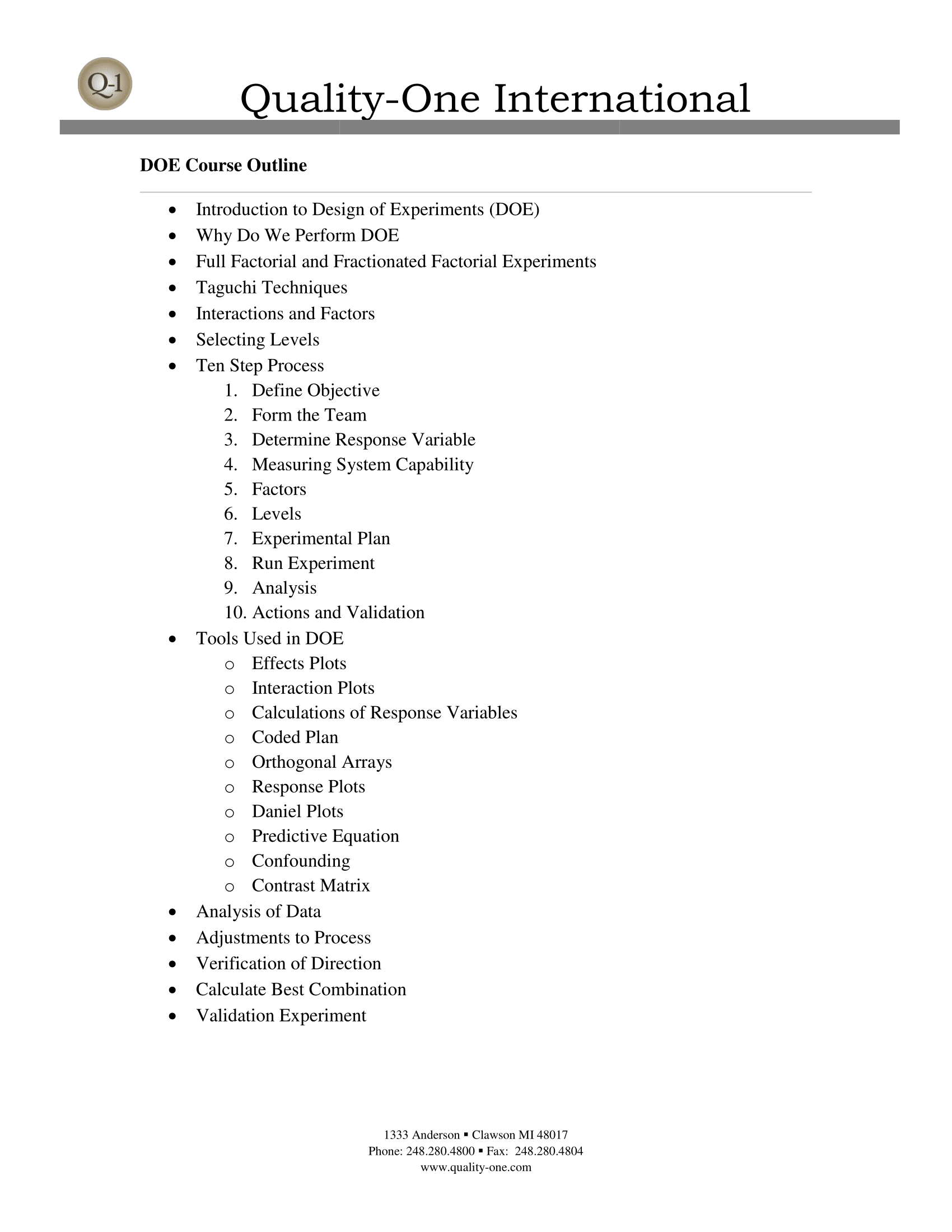DOE
– Design of Experiments –

Introduction to Design of Experiments (DOE)
If you look at many industries today you see similar products being offered by multiple manufacturers. Many companies today are frequently re-designing their products in an attempt to make their product stand out from the crowd. In addition, a great number of manufacturers are constantly developing new products to gain a foothold in other markets. With new products come new or changed processes. Every time we change a design or process we introduce new content. The amount of new content can be equated to the level of risk in the design or process. Product validation testing and prototype production runs are effective, but costly and in many cases problems are detected late in the development process. Engineers must use various analysis tools and statistical methods to reduce risk in a design or process. They must evaluate every change and how it could affect the process output. If you have multiple changes occurring at one time you could be multiplying your risk. So what can be done to predict how a set of changes will likely affect the process output? Design of Experiments (DOE) is a statistical tool available to engineers that can be used to evaluate single changes or multiple changes to a process at once and predict the resulting change to the output of the process.
What is Design of Experiments (DOE)
Design of Experiments (DOE) is a branch of applied statistics focused on using the scientific method for planning, conducting, analyzing and interpreting data from controlled tests or experiments. DOE is a mathematical methodology used to effectively plan and conduct scientific studies that change input variables (X) together to reveal their effect on a given response or the output variable (Y). In plain, non-statistical language, the DOE allows you to evaluate multiple variables or inputs to a process or design, their interactions with each other and their impact on the output. In addition, if performed and analyzed properly you should be able to determine which variables have the most and least impact on the output. By knowing this you can design a product or process that meets or exceeds quality requirements and satisfies customer needs.
Why Utilize Design of Experiments (DOE)
DOE allows the experimenter to manipulate multiple inputs to determine their effect on the output of the experiment or process. By performing a multi-factorial or “full-factorial” experiment, DOE can reveal critical interactions that are often missed when performing a single or “fractional factorial” experiment. By properly utilizing DOE methodology, the number of trial builds or test runs can be greatly reduced. A robust Design of Experiments can save project time and uncover hidden issues in the process. The hidden issues are generally associated with the interactions of the various factors. In the end, teams will be able to identify which factors impact the process the most and which ones have the least influence on the process output.
When to Utilize Design of Experiments (DOE)
Experimental design or Design of Experiments can be used during a New Product / Process Introduction (NPI) project or during a Kaizen or process improvement exercise. DOE is generally used in two different stages of process improvement projects.
- During the “Analyze” phase of a project, DOE can be used to help identify the Root Cause of a problem. With DOE the team can examine the effects of the various inputs (X) on the output (Y). DOE enables the team to determine which of the Xs impact the Y and which one(s) have the most impact.
- During the “Improve” phase of a project, DOE can be used in the development of a predictive equation, enabling the performance of what-if analysis. The team can then test different ideas to assist in determining the optimum settings for the Xs to achieve the best Y output.
Some knowledge of statistical tools and experimental planning is required to fully understand DOE methodology. While there are several software programs available for DOE analysis, to properly apply DOE you need to possess an understanding of basic statistical concepts.
How to Perform a Design of Experiments (DOE)
A DOE generally consists of the following four main phases, detailed below.
The Experimental Plan
- Gain a thorough understanding of the process being analyzed
- Include all inputs and outputs of the process
- Define the problem or goal of the experimenter
- Clearly identify any specific questions that you need the experiment to answer
- List the known or expected sources of variability in the experimental units (X)
- Determine how to identify and block the uncontrollable inputs (S)
- The method of measurement for the output (Y) should be determined
- Attribute measures (pass / fail) should be avoided
- Measurement Systems Analysis (MSA) should be performed (if not previously completed) on the selected measurement system
The Test
- The test matrix should include all variables and identify all possible combinations for each of the controllable input factors of the process
- The number of variables is up to the experimenter
Analyze the Results
After completing the experiment and collecting the data, the next step is to analyze the data and determine which input factors (X) or interactions (S) had the most impact on the process output (Y). By analyzing the data the experimenter can optimize the process by determining the combination of variables that produce the most desirable process output (Y).
Determine Appropriate Actions
Once the experiment is complete and the data is analyzed, actions must be identified to improve the process. The experimenter or team should determine any appropriate actions to be taken, assign an owner and a due date for each action.
DOE Example
The example described below is a simple experiment meant only to demonstrate the four steps of a basic Design of Experiments. Using DOE on your processes will most likely involve several input factors (X) and multiple interactions (S). Examining each factor individually would require a tremendous amount of time and resources. Using DOE enables the experimenter to examine multiple factors at once, including the effect of interactions between factors, reducing the required number of runs, thus saving time and valuable resources.
- Let’s say we want to evaluate the inputs of sunlight and water in relation to a plants growth. Use the formula 2n to determine how many tests need to be run. The letter n is equal to the number of factors being examined. For our two factor (sunlight and water) experiment, four runs are required. We will need to represent each factor at its highest and lowest points. The experiments need to be performed in a randomized fashion.
- For each of the input factors, determine the high and low levels to be used for the experiment. While the levels may be outside of the range currently applied, make sure they are still realistic. There will be uncontrollable factors, such as soil temperature, involved that must be blocked from the experiment. For our example, the levels will be as follows:
- Controllable Factor A: Water, Levels: 50 to 1.5 cups per day
- Controllable Factor B: Sunlight, Levels: 1 to 3 hours per day
- Uncontrollable Factors could include soil temperature
- For our experiment, the amount of sunlight per day had a greater effect on the plant growth and the effect of the interactions was insignificant
Design of Experiments (DOE) Services
DOE Services from Quality-One include DOE Consulting, DOE Training and DOE Project Support, such as Facilitation, Contract Services and Auditing. Our experienced team of highly trained professionals will provide a customized approach for developing your people and processes based on your unique needs. DOE Consulting will assist with the design of your DOE process, review your needs and available resources to properly plan and implement DOE at your facility. DOE Training will help team members understand and perform DOEs effectively and efficiently. Hands-on DOE Project Support will help to build and deploy your DOE process throughout the entire organization. By utilizing our experienced Subject Matter Experts (SME) to work with your teams, Quality-One can help you optimize your processes with DOE methodology and promote continuous improvement thinking in your organization.
Learn More About Design of Experiments (DOE)
Quality-One offers Quality and Reliability Support for Product and Process Development through Consulting, Training and Project Support. Quality-One provides Knowledge, Guidance and Direction in Quality and Reliability activities, tailored to your unique wants, needs and desires. Let us help you Discover the Value of DOE Consulting, DOE Training or DOE Project Support.


